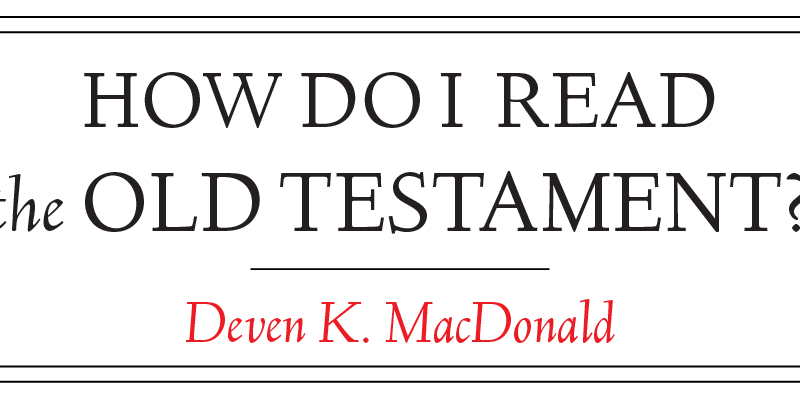
How do I read the Old Testament? (Deven K. MacDonald)
In the recent issue of Credo Magazine, “By the Book: How Well Do You Know the Bible?”, Deven K. MacDonald has contributed a very practical and helpful article called: “How do I read the Old Testament?” If you are intimidated by the Old Testament, this article will help you know how to approach the Old Testament so that you can comprehend it better. Deven K. MacDonald is Associate Pastor of Summerside Community Church in London ON Canada. He holds a BA (Hons) from Crandall University, MA (New Testament) from Acadia University and is currently a PhD candidate at Pretoria University. He is passionate about helping people understand the centrality and supremacy of Jesus in all things.
Here is the start of MacDonald’s article:
The New Testament doesn’t occur in a vacuum. Jesus and the Apostles understood the Gospel message as being the fulfillment of the Old Testament story of Israel. They understood it to be further building upon what was already revealed in the OT; not as a plan “B.” The writers of the NT quote the OT 343 times and allude to it another 2,309 times! We can’t understand the death and resurrection of Jesus in all its beauty and significance unless we understand the OT. If we want to “get” the gospel, we first need to get into the OT. But let’s be honest, it can be a bit intimidating at times. Even so, the OT is God’s Word and, as such, is “profitable for teaching, rebuking, correcting and training in righteousness” (2 Tim. 3:16). So, here are a few thoughts to help us get our understanding of it right and to make it more accessible.
Let’s start by getting a few basic facts straight: The OT is not one book; it’s a library of books—39 to be exact. It was written over a period of around 1,000 years (1500-400 B.C.), and authored by a diverse group of people including kings, prophets, shepherds, and generals. It features a number of different genres including history, narrative, poetry, wisdom, lament, and apocalyptic literature. It was written on three different continents. It is almost entirely written in the Hebrew language (and some Aramaic).
Get the big-story
First, it is crucial that you “get” the Big-Story. When you are studying a passage, it’s important to place yourself in the original audience’s shoes and think about what God had revealed about himself at this point in their history. Abraham, likely, had less revealed to him about God’s character than Isaiah did. Fit the story or passage that you are studying into the larger story of God’s redemption plan. To do this, you may need to print off a time-line of significant events or write out chapter titles for the book(s) you’re studying. So, let’s take a moment and look at the big story of the OT. …
Read the rest of this article today!
View the magazine as a PDF (Click Here)
 How well do you know your Bible? Now that is a scary question, even if you have been a Christian for a long time. Between church events, little league games, and a full-time job, finding time to read and study Scripture is a herculean task. To make matters worse, when you finally do escape to read the Bible you struggle to understand what it means. At times you can relate with the Ethiopian eunuch who said to Philip when asked if he understood what he was reading, “How can I, unless someone guides me?”
How well do you know your Bible? Now that is a scary question, even if you have been a Christian for a long time. Between church events, little league games, and a full-time job, finding time to read and study Scripture is a herculean task. To make matters worse, when you finally do escape to read the Bible you struggle to understand what it means. At times you can relate with the Ethiopian eunuch who said to Philip when asked if he understood what he was reading, “How can I, unless someone guides me?”
In this issue of Credo Magazine we are here to help! If you feel tired and frustrated, this issue will give you that shot of adrenaline you need to keep going. And if you feel like you just don’t have the tools in your belt to interpret the Bible properly, then you are in good hands. Consider this an exercise in going to the hardware store to find those tools you need to comprehend the Bible. Obviously this issue of the magazine won’t give you all the tools you need, but we hope to get you started, even provide you with the motivation you need to study the Bible on your own. Sure, it’s hard work. But hard work pays off. And maybe one day you will be able to say, “Hey, I do know the Bible, and I think I can help someone else understand it too.”
Contributors include: Robert Plummer, Ardel Caneday, Michael Kruger, Deven K. MacDonald, Paul D. Wegner, Augustus Nicodemus Lopes, Kevin DeYoung, Douglas Moo, and Thomas Schreiner.
